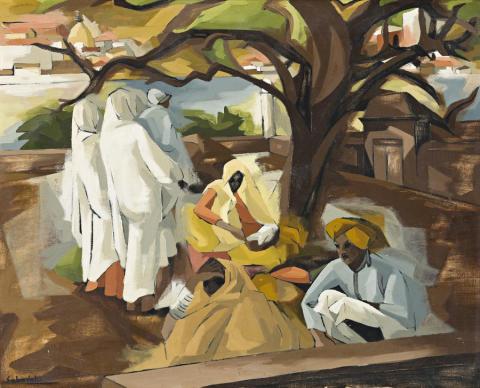THE BUNDI COURTYARD, c.1957
JEHANGIR SABAVALA
oil on canvas
64.0 x 79.0 cm
signed lower left: Sabavala
artist's name and title inscribed on label verso
Collection of Sir Kenneth Wills and Lady Wills, Adelaide, acquired in Bombay (Mumbai), India, 1960s
Thence by descent
Private collection, Melbourne
'He is a poet of solitude and of seashore, estuary and mountain, the dreamer amidst clouds and mists who, when he paints people, depicts them as if they too were themselves immersed in a dream.'1
The Bundi Courtyard and the Water Pump, Jaipur were most likely included among one of Jehangir Sabavala's earliest solo exhibitions in Mumbai in the 1950s. Stylistically they are firmly placed in this period and their aged, hand cut labels on the reverse written in a humble and simple script further attest to this. The young artist was born into the aristocratic and somewhat Edwardian family of Sir Jehangir Cowasjee Jehangir, Baronet and brought up in the neo-classical mansion, Readymoney House in old Bombay. He had just returned to Mumbai with his new wife Shirin, who he met at the London School of Economics, from extensive studies in London and Paris. First at the Heatherly School of Fine Art, London (1945-47) and then the Academie Andre Lhote and the Academie Julian, Paris (1948-51). The newlyweds moved into a bungalow attached to the family residence 'Aewan-e-Rafiyat', a legacy to Jehangir from his grandmother, Dhunbai, Lady Jehangir. During his self-imposed exile in Europe, India had undergone extraordinary political and social upheavals and he returned to Independence and the Partition, which had dramatically divided the country into secular India and Islamic Pakistan. Amid this dislocation and turmoil and with the help of fellow artist MF Hussain, the Sabavalas staged Jehangir's first exhibition at the Taj Mahal Hotel, Mumbai in 1951. While many local critics decried his formalism and indeed apparent 'Europeanism', his work was met with significant early success and recognition and in 1954 he represented India at the Venice Biennale.
For many there was a universal aesthetic to Sabavala's paintings and a sensibility that conjured up deep feelings of nostalgia for a world pre-industrialisation and a place of timelessness. The Sabavala landscape is almost metaphysical a deeply spiritual place of calm and quietude. As Kathy Zhang thoughtfully wrote in her obituary of the artist,'During a period when themes of 'Indian-ness' and the pursuit of a uniquely Indian style were driving forces in the contemporary art scene, Sabavala was disparaged in the 1950s and 1960s as a 'westernized elitist', who was out of touch with 'real India'. On the other hand, his ethereal or wraithlike evocations of the physical world earned him the regalement of the poets Ranjit Hoskote, Jerry Pinto and Arundhathi Sumbramaniam. They viewed Sabavala's work rather as allegoric landscapes of dislocation of an artist who found himself an émigré in Democratic India as he was in Europe. Sabavala, when questioned on his predilection for painting landscapes, told art historian Yashodhara Dalmia in a 2004 interview, 'I think, as a painter, in all those hours spent alone, you are not only thinking of the painting. You are thinking of yourself, of death, of mortality, of tragedies and happiness.' For the artist, his paintings were not landscapes, but subliminal explorations into the human soul, which followed the Indian aesthetic of chetovistatra ('expansion of consciousness').'2
1. Lannoy, R., 'A Paradoxical Alliance', in Hoskote, R., Pilgrim, Exile, Sorcerer: The Painterly evolution of Jehangir Sabavala, Eminence Designs, Mumbai, 1998, p. 13
2. Zhang, K.,'Obituary - Jehangir Sabavala (1922 - 2011)', Art Asia Pacific, 27 September 2011
